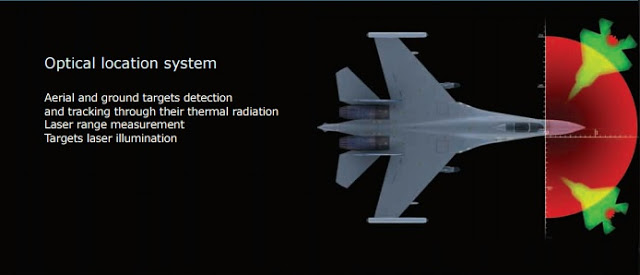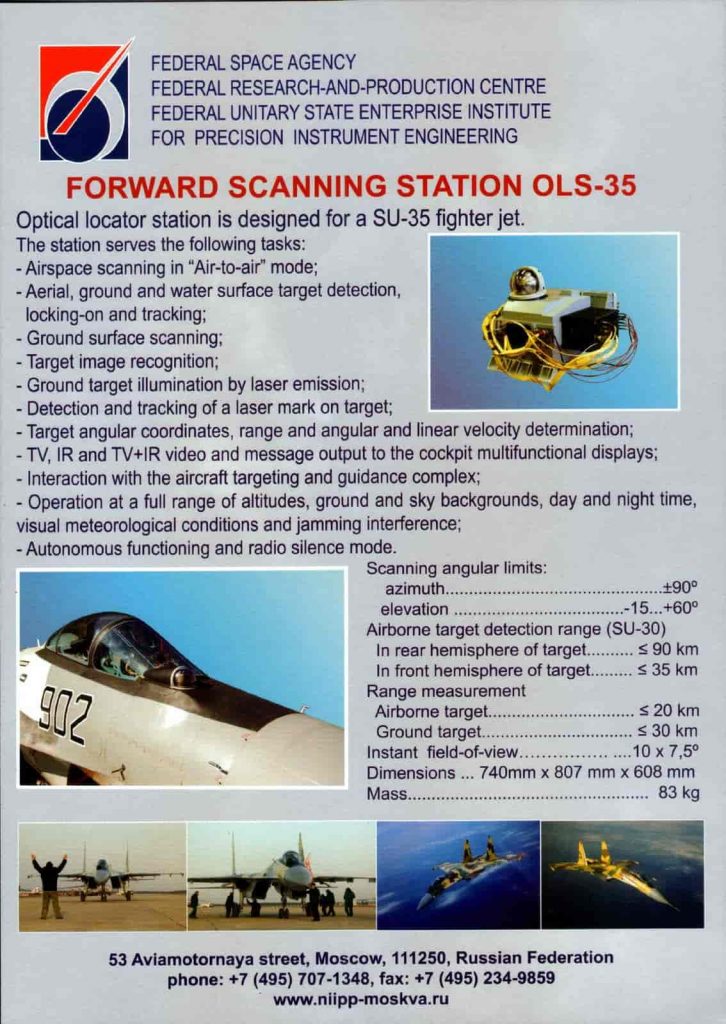ΣΧΟΛΙΟ ΙΣΤΟΛΟΓΙΟΥ : Κανείς δεν αμφιβάλλει, ότι το ρωσσικό θα υπερισχύσει σε εναέρια μάχη WVR. (Within Visual Range)...δηλαδή dogfights .!!
Το ζήτημα είναι αν σε πραγματική μάχη, θα προλάβει ποτέ να βρεθεί υπό τέτοιες συνθήκες.
A Su-35S air-superiority fighter jet of Russia’s Aerospace Force has intercepted and visually identified the U.S. F-22 Raptor Raptor combat aircraft flying over Syria.
A photographs posted by unofficial Russia’s military pilot Instagram account on 24 September has confirmed an intercept of the U.S. F-22 Raptor Raptor combat aircraft by the Russian Su-35S fighter jet.
Photographs, made by the infrared search and track fire control system of the Russian Su-35S, shows in infrared spectrum an F-22 Raptor fighter jet flying over Syria.
The Su-35S infrared search and track system called the OLS-35 and includes an infrared sensor, laser rangefinder, target designator and television camera. This system to determine the general position of aircraft within a fifty-kilometer radius—potentially quite useful for detecting stealth aircraft, such as F-22, at shorter ranges.
The systems scans the airspace ahead of the jet for heat signatures caused by aircraft engines and/or plane’s surface friction caused by the aircraft flying through the air.
According to the Deagel.com, OLS-35 comprises a heat-seeker, a laser rangefinder/designator with new algorithms and advanced software to outperform its predecessor installed on the Su-27/Su-30 aircraft family. The Su-35 IRST is superior to the OEPS-27 in terms of range, precision and reliability.
But, the Su-35’s infrared search and track system (IRST) does not represent a panacea solution against stealth aircraft.


The OLS-35, like and other IRST, does not provide target quality track data for weapons employment. For example, if a Russian Su-35 fighter jet detected an approaching forward aspect F-22, the Russian pilot could not directly utilize the IRST data to direct semi-active, active, or passive homing missiles; laser illumination capabilities are generally a means to guide air-to-ground munitions rather than air-to-air missiles.

ΠΗΓΗ
Το ζήτημα είναι αν σε πραγματική μάχη, θα προλάβει ποτέ να βρεθεί υπό τέτοιες συνθήκες.
A Su-35S air-superiority fighter jet of Russia’s Aerospace Force has intercepted and visually identified the U.S. F-22 Raptor Raptor combat aircraft flying over Syria.
A photographs posted by unofficial Russia’s military pilot Instagram account on 24 September has confirmed an intercept of the U.S. F-22 Raptor Raptor combat aircraft by the Russian Su-35S fighter jet.
Photographs, made by the infrared search and track fire control system of the Russian Su-35S, shows in infrared spectrum an F-22 Raptor fighter jet flying over Syria.
The Su-35S infrared search and track system called the OLS-35 and includes an infrared sensor, laser rangefinder, target designator and television camera. This system to determine the general position of aircraft within a fifty-kilometer radius—potentially quite useful for detecting stealth aircraft, such as F-22, at shorter ranges.
The systems scans the airspace ahead of the jet for heat signatures caused by aircraft engines and/or plane’s surface friction caused by the aircraft flying through the air.
According to the Deagel.com, OLS-35 comprises a heat-seeker, a laser rangefinder/designator with new algorithms and advanced software to outperform its predecessor installed on the Su-27/Su-30 aircraft family. The Su-35 IRST is superior to the OEPS-27 in terms of range, precision and reliability.
But, the Su-35’s infrared search and track system (IRST) does not represent a panacea solution against stealth aircraft.


The OLS-35, like and other IRST, does not provide target quality track data for weapons employment. For example, if a Russian Su-35 fighter jet detected an approaching forward aspect F-22, the Russian pilot could not directly utilize the IRST data to direct semi-active, active, or passive homing missiles; laser illumination capabilities are generally a means to guide air-to-ground munitions rather than air-to-air missiles.

ΠΗΓΗ

Δεν υπάρχουν σχόλια:
Δημοσίευση σχολίου